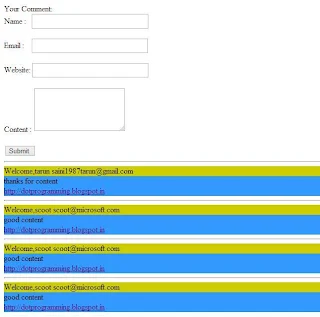Basically CommentBox shows list of data. So we can use repeater control for this types of application.The Basic logic behind of this application is.
- Feed your user data to database table first
- Show data from database table using repeater control.
Introduction on repeater control
The Repeater control is a data bound control that is used to display repeated list of items from the associated data source. It is a single WebControl that allows splitting markup tags across the templates . The Repeater control does not provide support to in-Built layout or styles . Therefore, While working with the repeater control you have to explicitly declare all layout , formatting , and style. In other words , The Repeater control does not support built-in selection or editing features.
Create database Table
Make Stored procedure
CREATE PROCEDURE insrtdata
AS
select * from commentbox
RETURN 0
AS
select * from commentbox
RETURN 0
<%@ Page Language="C#" %>
<!DOCTYPE html>
<script runat="server">
protected void Page_Load(object sender, EventArgs e)
{
System.Data.SqlClient.SqlConnection con = new System.Data.SqlClient.SqlConnection();
con.ConnectionString = ConfigurationManager.ConnectionStrings["ConnectionString"].ToString();
con.Open();
System.Data.SqlClient.SqlCommand cmd = new System.Data.SqlClient.SqlCommand();
cmd.CommandText = "insrtdata";
cmd.CommandType = System.Data.CommandType.StoredProcedure;
cmd.Connection = con;
System.Data.SqlClient.SqlDataAdapter da = new System.Data.SqlClient.SqlDataAdapter(cmd);
System.Data.DataSet ds = new System.Data.DataSet();
da.Fill(ds);
Repeater1.DataSource = ds;
Repeater1.DataBind();
}
protected void Button1_Click(object sender, EventArgs e)
{
System.Data.SqlClient.SqlConnection con = new System.Data.SqlClient.SqlConnection();
con.ConnectionString = ConfigurationManager.ConnectionStrings["ConnectionString"].ToString();
con.Open();
System.Data.SqlClient.SqlCommand cmd = new System.Data.SqlClient.SqlCommand();
cmd.Parameters.AddWithValue("@na",nametxt .Text);
cmd.Parameters.AddWithValue("@em",emailtxt .Text);
cmd.Parameters.AddWithValue("@web",webtxt .Text);
cmd.Parameters.AddWithValue("@con",contenttxt .Text);
cmd.CommandText = "insert into [commentbox](Name,Email,Website,Content)values(@na,@em,@web,@con)";
cmd.Connection = con;
cmd.ExecuteNonQuery();
}
</script>
<html xmlns="http://www.w3.org/1999/xhtml">
<head runat="server">
<title></title>
</head>
<body>
<form id="form1" runat="server">
<div>
Your Comment:<br />
Name :
<asp:TextBox ID="nametxt" runat="server" Height="24px" Width="231px"></asp:TextBox>
<br />
<br />
Email : <asp:TextBox ID="emailtxt" runat="server" Height="23px" Width="230px"></asp:TextBox>
<br />
<br />
Website:
<asp:TextBox ID="webtxt" runat="server" Height="23px" Width="230px"></asp:TextBox>
<br />
<br />
Content :
<asp:TextBox ID="contenttxt" runat="server" Rows="5" TextMode="MultiLine"></asp:TextBox>
<br />
<br />
<asp:Button ID="Button1" runat="server" OnClick="Button1_Click" Text="Submit " />
</div>
<asp:Repeater ID="Repeater1" runat="server">
<ItemTemplate>
<hr />
<div style="background-color: #CCCC00">
Welcome,<asp:Label ID="Label1" runat="server" Text='<%# Eval("Name") %>'></asp:Label>
<asp:Label ID="Label2" runat="server" Text='<%# Eval("Email") %>'></asp:Label>
</div>
<div style="background-color: #3399FF">
<asp:Literal ID="lit" runat ="server" Text ='<%# Eval("Content") %>' Mode ="Transform" />
<br />
<asp:HyperLink ID="HyperLink1" runat="server" NavigateUrl ='<%# Eval("Website") %>' Text ='<%# Eval("Website") %>' />
</div></ItemTemplate>
</asp:Repeater>
</form>
</body>
</html>
Output
<!DOCTYPE html>
<script runat="server">
protected void Page_Load(object sender, EventArgs e)
{
System.Data.SqlClient.SqlConnection con = new System.Data.SqlClient.SqlConnection();
con.ConnectionString = ConfigurationManager.ConnectionStrings["ConnectionString"].ToString();
con.Open();
System.Data.SqlClient.SqlCommand cmd = new System.Data.SqlClient.SqlCommand();
cmd.CommandText = "insrtdata";
cmd.CommandType = System.Data.CommandType.StoredProcedure;
cmd.Connection = con;
System.Data.SqlClient.SqlDataAdapter da = new System.Data.SqlClient.SqlDataAdapter(cmd);
System.Data.DataSet ds = new System.Data.DataSet();
da.Fill(ds);
Repeater1.DataSource = ds;
Repeater1.DataBind();
}
protected void Button1_Click(object sender, EventArgs e)
{
System.Data.SqlClient.SqlConnection con = new System.Data.SqlClient.SqlConnection();
con.ConnectionString = ConfigurationManager.ConnectionStrings["ConnectionString"].ToString();
con.Open();
System.Data.SqlClient.SqlCommand cmd = new System.Data.SqlClient.SqlCommand();
cmd.Parameters.AddWithValue("@na",nametxt .Text);
cmd.Parameters.AddWithValue("@em",emailtxt .Text);
cmd.Parameters.AddWithValue("@web",webtxt .Text);
cmd.Parameters.AddWithValue("@con",contenttxt .Text);
cmd.CommandText = "insert into [commentbox](Name,Email,Website,Content)values(@na,@em,@web,@con)";
cmd.Connection = con;
cmd.ExecuteNonQuery();
}
</script>
<html xmlns="http://www.w3.org/1999/xhtml">
<head runat="server">
<title></title>
</head>
<body>
<form id="form1" runat="server">
<div>
Your Comment:<br />
Name :
<asp:TextBox ID="nametxt" runat="server" Height="24px" Width="231px"></asp:TextBox>
<br />
<br />
Email : <asp:TextBox ID="emailtxt" runat="server" Height="23px" Width="230px"></asp:TextBox>
<br />
<br />
Website:
<asp:TextBox ID="webtxt" runat="server" Height="23px" Width="230px"></asp:TextBox>
<br />
<br />
Content :
<asp:TextBox ID="contenttxt" runat="server" Rows="5" TextMode="MultiLine"></asp:TextBox>
<br />
<br />
<asp:Button ID="Button1" runat="server" OnClick="Button1_Click" Text="Submit " />
</div>
<asp:Repeater ID="Repeater1" runat="server">
<ItemTemplate>
<hr />
<div style="background-color: #CCCC00">
Welcome,<asp:Label ID="Label1" runat="server" Text='<%# Eval("Name") %>'></asp:Label>
<asp:Label ID="Label2" runat="server" Text='<%# Eval("Email") %>'></asp:Label>
</div>
<div style="background-color: #3399FF">
<asp:Literal ID="lit" runat ="server" Text ='<%# Eval("Content") %>' Mode ="Transform" />
<br />
<asp:HyperLink ID="HyperLink1" runat="server" NavigateUrl ='<%# Eval("Website") %>' Text ='<%# Eval("Website") %>' />
</div></ItemTemplate>
</asp:Repeater>
</form>
</body>
</html>


